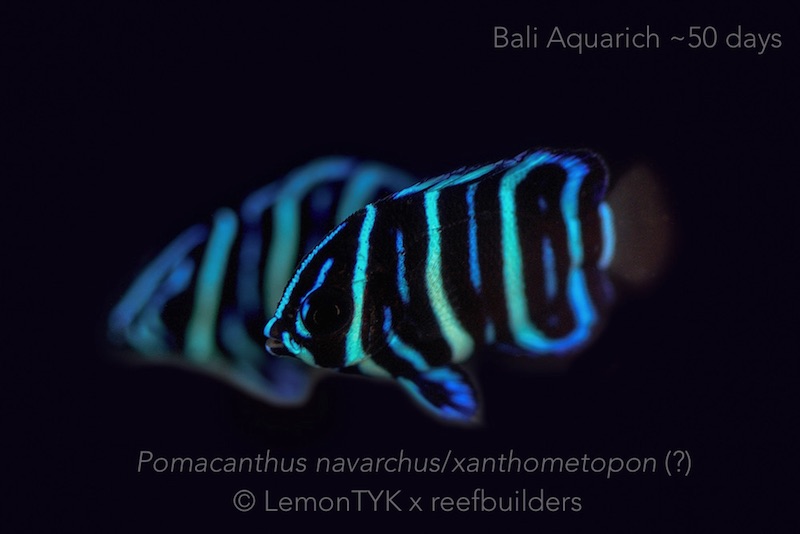Majestic angelfish have now been spawned, bred and reared by Bali Aquarich, the trailblazer in captive breeding of aquarium angelfish. With more than two years of snagging new captive bred angelfish ‘species firsts’ like it’s a race, Bali Aquarich can officially claim one more species to their hall of trophies, Pomacanthus navarchus.
When we were growing up in the hobby back in the 90s, Euxiphipops was a good identifiable genus of angelfish which contained Blueface angelfish, E. xanthometopon, the Majestic angelfish, and the little appreciated Sixbar angelfish, E. sexstriatus. The trio of reef beauties in this now-subgenus all share a similar juvenile color pattern, and rounded dorsal and anal fins as adults.

Just a few months ago we shared the news that Bali Aquarich had spawned an angelfish species falling within the Euxiphipops subgenus of Pomacanthus. However Bali Aquarich keeps quite the mix of broodstock adult angelfish in the same tank, including both blueface and majestic angelfish, therefore making it impossible to say for certain, at the time, which species had been successfully raised.
Back in July the little tiny post-larval angelfish larvae had the scantest thin curved blue lines traversing their jet black bodies. The itty bitty 50-day old fish divulged their Euxiphipops heritage, but the species level determination eluded any educated guesses and the whole world, including Bali Aquarich, simply had to wait to see what colors would become revealed by the young fish as they grew larger and developed more mature coloration.

Now that the little angelfish are over four months old and 3cm (1.2 inches), they are starting to show that faded yellow glow of juvenile Majestic angelfish that develops in the center of the dorsal fin first, and slowly spreads its way down the body. By contrast, juvenile blueface angelfish tend to lose their juvenile coloration all over the body at the same time, save for the curved juvenile bars which take longer to go away.
We are told that these fish grow particularly slow compared to the species that Bali Aquarich has grown in the past, which further confirms the Majestic angelfish identification, since this species is also known to be particularly slow to grow and mature into full adult coloration. Bali Aquarich will soon begin shipping this limited batch of the world’s first first captive bred majestic angelfish but they’ll be keeping a few for themselves to grow out in case they hit the jackpot . . .

Remember a few paragraphs above when we told you that the blueface and majestic angelfish broodstock parents are kept in the same tank? Well there’s a remote possibility that some of the offspring of Majestic angelfish may have been the result of a hybrid crossing between the two related Euxiphipops angelfishes. By now it’s already clear that the genetics of this crop of angelfish are dominated by Pomacanthus navarchus, but if some of these angelfish were the result of crossbreeding with P. xanthometopon, we wouldn’t even know what that looks like as a juvenile.
Hybrids of closely related species of wrasses, anthias and many other reef fish can be really hard to discern, even as adults; sometimes the difference can be so subtle that only a dyed-in-the-wool fish nerd would even take notice. But adult hybrid angelfish are usually the result of two very different looking species so the pattern that develops can be quite amazing, especially in the larger species of Pomacanthus.
Hybrids of blueface and majestic angelfish are so rare, that we only know of one documented specimen, pictured above. The conditions that Bali Aquarich have set up to breed pure species of angelfish is also a perfect storm of the remotest possibility that a hybrid offspring of blueface and majestic angelfish has occurred. We aren’t the betting type, and Bali Aquarich’s captive bred angelfish should be enjoyed for what they are, but if we had the tank space we’d buy up more than one of these Balinese-bred majestic angelfish in the off-chance that one of them could be even more special than the rest.




